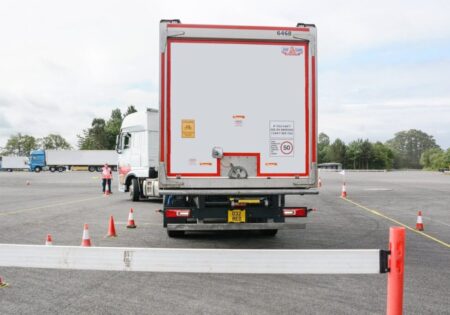
On average you can expect to earn between £30,0000 to £40,000 per year as a lorry driver in the UK. With additional experience and training this salary can increase further and there are many HGV Class 1 qualified driver positions that pay £45,000+ per year.
Sounds great, but it’s important to remember that there are many factors that can impact how much a lorry driver can earn. For example, driver experience, geographic location, industry sector and the size of the company, can all have a significant impact on a driver’s earning potential. More experienced drivers often earn higher salaries compared to those who are just starting their careers, while larger companies or those in high-demand sectors may offer better compensation packages for HGV drivers.
Possessing additional qualification and licences can also increase a lorry driver’s earning potential. Specialised driving, such as transporting dangerous goods or driving long-distance routes, may offer higher pay rates compared to local or regional driving. Some companies may also offer additional pay for working night shifts, weekends, or overtime hours.
There are a number of different jobs that LGV and HGV drivers can do depending on their licence, experience, and personal preferences. As a rough guide there are three main categories of driver jobs:

Local or regional driving jobs involve working within a specific area or region and involve dropping off multiple, smaller deliveries across the working day. You may work for courier companies, logistics providers, or retail businesses, to deliver goods to customers or businesses. Being a local driver offers several benefits that make it an attractive career choice for many individuals. You typically have more predictable and consistent work schedules compared to long-haul drivers which can provide a better work-life balance and allow for more time spent with family and loved ones.
Salary expectations do tend to be lower than HGV driving jobs, so you should expect to earn around £23,000-£28,000 (or £11-£14 per hour) as a full-time delivery driver.
To be a local delivery driver you need a valid driving licence that corresponds to the type of vehicle you will be driving. The specific driving licence category required will vary depending on the size and weight of the vehicle you’ll be operating. The following licence categories are usually the most relevant for local delivery drivers:

As a short-haul driver, you can expect a rewarding and dynamic career. This role tends to involve driving in a local area but with a wider reach than a local driving job. Short-haul driving offers the opportunity to build relationships with local businesses, customers, and colleagues. You may have the chance to transport a diverse range of goods, including perishable items, retail products, or specialised cargo. This variety keeps the job interesting and allows you to gain valuable experience in different sectors, broadening your skill set and enhancing your professional development. Many industries rely on local distribution networks, and the demand for efficient and reliable transport within a specific region remains consistent. This can offer you a secure career path with potential opportunities for advancement or specialisation.
As a short haul delivery driver, you can expect to earn around £28,000 to £33,000 per year.
The specific driving licence category required for a short haul driver will vary depending on the size and weight of the vehicle you’ll be operating, but the following licence categories are the most common for short-haul drivers:
LGV/HGV Category C (Large Goods Vehicle): For short-haul drivers operating larger vehicles over 7.5 tonnes, such as rigid lorries or trucks, a Category C licence is required.

Long-haul driving often involves operating larger vehicles, such as articulated lorries or tractor-trailers. These vehicles require specialised training and skills to handle, consequently there is a big demand for qualified and experienced HGV drivers. As a long-haul driver you can expect to spend a significant amount of time on the road, travelling long distances across different regions or even countries. You’ll have the chance to explore diverse routes and destinations which can make your work engaging and interesting.
Long-haul driving has the highest earning potential compared to local or short-haul drivers. You can expect a HGV driver salary to be between £35,000 and £40,000+, but a £45,000+ salary is not uncommon for an experienced Class 1 driver. Plus, you’ll often receive additional compensation for the time spent away from home, and certain routes or assignments may offer higher pay rates due to their distance or complexity.
The following licence categories are the most relevant for HGV drivers in the UK:
Category C+E: If you aspire to drive articulated lorries or vehicles with a trailer weighing over 750 kilograms, you will need a Category C+E licence. This licence allows you to operate larger and heavier HGV combinations and drivers with this licence can command the highest rates of pay.
As a HGV driver, you will also need to complete Driver CPC (Certificate of Professional Competence) training to work legally and operate commercially. The training is required if you drive vehicles over 3.5 tonnes professionally, and applies to drivers of both rigid HGVs and articulated lorries. The Driver CPC qualification comprises two parts: the initial qualification and ongoing training. The initial qualification is obtained by passing both the theory and practical tests before being eligible to work as a professional HGV driver. The ongoing, periodic training consists of completing 35 hours of approved training every five years to maintain and renew the Driver CPC qualification.

The course usually starts with theoretical instruction covering topics such as highway code, traffic regulations, and safe driving practices specific to HGVs. This includes learning about vehicle systems, handling techniques, and understanding potential hazards on the road.

The practical driving component is a crucial part of HGV driver training. It involves hands-on experience behind the wheel of an HGV under the guidance of a qualified instructor. You’ll learn various driving techniques, including manoeuvring, changing lanes, reversing, and handling different road conditions.

You will become familiar with the specific HGV you will be driving during the training. This includes understanding the vehicle’s controls, instruments, and safety features. It’s important to learn how to perform pre-trip inspections to ensure the vehicle is in proper working condition before each journey.

HGV driver training emphasises hazard perception and defensive driving techniques. You’ll learn how to anticipate and respond to potential dangers on the road, such as blind spots, vulnerable road users, and challenging road conditions. This helps develop a safety-conscious mindset while driving a HGV.

Throughout the training, you’ll undergo practical skills assessments to evaluate your driving proficiency and ensure you meet the required standards for HGV drivers. These assessments may include both on-road driving tests and off-road exercises to demonstrate your competence in vehicle control and manoeuvring.
Here at RED, we specialise in light and heavy goods vehicle driver training. Our intensive courses typically last for 4 or 5 days and include the practical test on the final day of your course. You’ll work one-to-one with a qualified RED instructor to cover everything you need to pass your practical driving test.